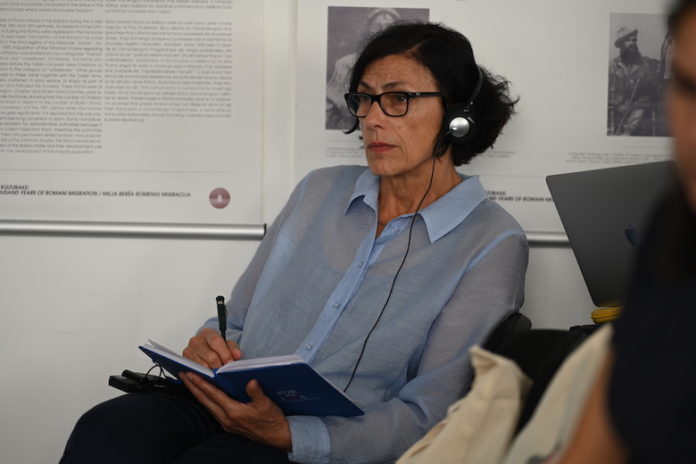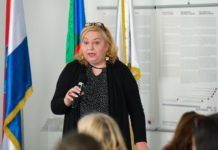Dr. Karola Fings is a German historian who leads at Heidelberg University the project “Encyclopaedia of the Nazi Genocide of Sinti and Roma in Europe”. She earned her doctorate at the Heinrich-Heine-University in Düsseldorf with a study about the concentration camps system. The Nazi persecution of Sinti and Roma and the manner in which the minority was dealt with after 1945 is one of her research priorities. Since 1990 she has published extensive portrayals, local and regional studies, and special investigations into this subject and contributed towards establishing the topic both in research and in education. This year Croatia is holding the Presidency of the International Holocaust Remembrance Alliance (IHRA), and Ms. Fings is a participant at the Second International Conference on the Genocide of Roma. She is a member of the German delegation to the IHRA.
What is the project of Encylopaedia of the Nazi Genocide against Sinti and Roma, who is involved in it, and how is the project useful for young people and society in general?
When I started this project in 2020, the idea was to collect the knowledge we have about the genocide of Sinti and Roma in Europe. This is not a very easy task because for decades the genocide was understudied, and we didn’t have scientifically based research. But in the last 20 years, we have made a huge progress. The problem is that the scientists and the general public don’t have access to this knowledge because we have records in too many languages which a lot of experts don’t speak. Some publications can not be accessed because they are not in libraries. That is the reason why it is so important to improve the knowledge about the genocide, collect all we know, and introduce it to the public, especially to politicians.
I thought it would be helpful to collect and process it and make it easily accessible. That means that we will create an online platform and present historical knowledge from every country. The content – about 1,000 lemmas – will be sorted alphabetically from A to Z, which will help to find terms and answers connected with a specific topic. For example, when we question what we know about the persecution of Roma in the Independent State of Croatia. We will try to find information not only for each country but also for specific aspects like racial hygiene, laws, and so on. Crucial is that, for the first time, we will see the whole dimension of the genocide, hundreds of camps where Sinti and Roma had suffered, hundreds of places where the Roma were murdered. And on the other hand, we will see who was responsible for the massacres. Also, we will have many personal stories of victims and survivors. That is crucial for the understanding of the suffering of these people.
I would like to add that we established a cooperation with very prominent experts from more than 20 countries who conduct research and publish studies on these subjects. That is very valuable. We can improve knowledge through exchange between them, so they can improve the quality of the representation of the genocide. That is also a benefit of this project. I want to add that this project is generously founded by the German Federal Foreign Office. I am thankful to them because this initiative had obstacles so you need a respectful partner who has the will to bring this issue forward and supports it.
At the IHRA Conference in Zagreb, I met many international colleagues. The exchange of our knowledge is very valuable. From Croatia, we cooperate with Danijel Vojak who is a very important expert. This is already the second project on which we are cooperating. Before this one, we worked together on a project where we collected victims’ testimonies from the time of the Second World War. My collaboration with Danijel started in 2016 and he is a very good and reliable colleague.
In your work at the university, what are your experiences in working with students? Do students know the reality of the suffering of the Roma people?
In general, I can say that today more awareness exists about that than we had 20 years before. That is related to the fact that we have the huge Sinti and Roma Memorial in Berlin which was opened in 2012. That also has to do with NGOs’ activities and their remembrance work which spread awareness about this issue in the public. After all, we have memorial days which are national and international initiatives for spreading awareness about the genocide.
But when you talk with students about their knowledge, you’ll find out that factual knowledge is nearly close to zero. Most of them, for example, don’t understand the structure of the persecution of Roma and they don’t have an awareness of the long-lasting effect of these acts. Knowledge is not deep enough and we must intensify efforts to implement that knowledge in the schools. So the first thing is to teach that knowledge and the second one is to develop awareness about the dimensions of the genocide. Then we can discuss rising racism today and how to prevent that.
In your book Sinti und Roma: Geschichte einer Minderheit [Sinti and Roma. History of Minority] (2016, 20192) you dealt with the deconstruction of stereotypical views by incorporating the history of a minority in the general historical, cultural, and economic development. What stereotypes do you consider to be most prejudicial and devastating for the Roma community? What is the main obstacle for Roma in terms of economic and material conditions that prevent them from integrating into society?
I think the problem we have to face here is that antigypsyism is a very long-lasting historical phenomenon. It has nothing to do exclusively with stereotypes or something like that. Stereotypes are normal. We all have stereotypes, for example, about Germans. That’s why I think it was important to raise the issue of antigypsyism, or racism against Roma, as some prefer, to show that it has lasted over centuries.
Also, there have been specific concepts that had been created within the majority society that last until today. One of these images is that, in general, so-called Gypsies are aliens. Another image is that they have no fatherland, no homeland. Another image is that they do not fit into the majority society. These are the general images and then come the others. I don’t want to repeat them, because these are very distorted images which also always put Roma aside. It’s very, very hard work to get people to reflect upon the images they have. We all know that racism has effects on the actual situation of Sinti and Roma. It excludes them from very, very important general access to society, to education, etc. I think therefore it’s important to turn the perspective and to ask why we have these distorted images.
What was your motivation to devote your professional career to the community of Roma and Sinti? What was the inspiration or the turning point that brought you to this subject?
Well, I think it’s my conviction that in our democracies everyone has to have the same rights. As long as there are groups that are excluded from society and that have no access to fundamental rights, we have a problem in our society. And we must work to overcome it.
I found out that the living conditions and the social position of Roma and Sinti were very bad when I had my first interview with a survivor in 1988 in Cologne. She was a Sinti who survived the deportation and the camps. And she reported about her experiences after 1945. When I found out as a young student that she never received attention, that she never received recognition, and that she never received compensation for all the things she really survived, for all the losses she had, I was, on the one hand, very sad, and, on the other, I said, well, I have to work on this and I have to spread the knowledge about the persecution of Sinti and Roma.
This is a first step in order to raise awareness about it, to raise sensitivity, and also to make a little step towards historical justice. If you look at the situation of the survivors after 1945, no one helped them, no one supported them, and they were not recognized. This omission had, of course, effects on the lives not only of the survivors but also of the second and third generations. We know it lasts until today, that there is segregation and so on. That is not fair. We have to raise the awareness about this, we have to raise the knowledge, we have to improve the knowledge in order to overcome these discriminations, this structural discrimination.
I believe that the current situation of Roma in Croatia is maybe the best that has ever been. But that is primarily because there is someone who is in the middle of the political context, who can make them visible, who can make their problems visible, and who is engaged in solving their problems. In Germany, the situation is probably similar. But now in Germany, there is one political threat, namely the party Alternative for Germany, which is climbing up on the political scene. What do you think about these new trends in the German politics, especially towards the Roma?
In a lot of countries in Europe we face the rising of the right-wing parties. We definitely have to confront it because it endangers our democracies. Of course, we know that there are vulnerable groups that are targeted first. We have to stand side by side against it. It’s not only an attack against minorities or vulnerable groups, it’s an attack on the whole society and we all have to stand up against it.
Do you think that the National Socialist genocide is sufficiently explored, and within it particularly the suffering of Roma and Sinti?
The issue of the genocide of Sinti and Roma was for decades not known and was not researched. We still feel this deficit. There are more studies now but still, we do not know a lot about, for example, the atrocities that took place. We know that there were 180 sites of massacres in German-occupied Poland but we do not know all the details. We do not know how many people were killed and what their names were. We still do not know a lot about local situations, where the families lived, how the families lived, who were the perpetrators, and so on. We especially experience problems in identifying victims. Also, we often do not know how the persecution took place step by step in several countries.
We need to research more about what happened to the survivors, we need to spread the knowledge about the resistance of Roma, and how the persecuted reacted—in order to see them individually and also to show that they were not mere objects of persecution but that they had their own strategies to survive. Whenever we discuss in our several working groups we always find a lot of issues where we conclude that we need to visit the archives again to find out more.
Hopefully, we will be in a situation where we will have sustainable and permanent research. Our problem is that we have many small projects and we need a structure that works continuously in this field. The Encyclopaedia is a very small step to collecting knowledge, establishing an international network, and providing a tool that can be enriched over the years. I hope that we laid the ground for better, newer, and more extensive research.












